Lumus
Lumus is an Israeli-based Augmented Reality company headquartered in Ness Ziona, Israel.[2] Founded in 2000, Lumus has developed technology for see-through wearable displays, via its patented Light-guide Optical Element (LOE) platform to market producers of smart glasses and augmented reality eyewear. Lumus' technology enables a small natural looking form factor, wide field of view and true see-through performance.[3]
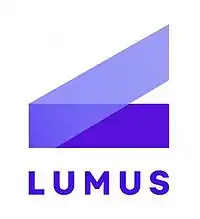 | |
Type of site | Private |
|---|---|
| Headquarters | , |
| CEO | Ari Grobman [1] |
| Key people | Shlomo Kalish (Chairman of the Board) |
| Industry | Augmented Reality, Consumer Electronics |
| URL | lumusvision |
Technology
The LOE is a patented [4] optical waveguide that makes use of multiple partial reflectors embedded in a single substrate to reflect a virtual image into the eye of the wearer. Specifically, the image is coupled into the LOE by a "Pod" (micro-display projector) that sits at the edge of the waveguide—in an eyeglass configuration, this is embedded in the temple of the glasses. The image travels through total internal reflection to the multiple array of partial reflectors and are reflected to the eye. While each partial reflector shows only a portion of the image, the optics are such that the wearer sees the combined array and perceives it as a single uniform image projected at infinity. The transparent display enables a virtual image to be seamlessly overlaid over the wearer's real world view. This is especially true when the source image comprises a black background with light color wording or symbology being displayed. Black is essentially see-through color, while lighter colored objects, symbols or characters appear to float in the wearer's line of sight. Conversely, full screen images like documents, internet pages, movies which are typically brighter colors can be displayed to look like a large virtual image floating a few meter's away from the wearer.
Lumus, with the LOE, has a single waveguide that works on all colors. The thickness of their one LOE is similar to the stack of multiple (one per red, green, and blue) thinner waveguides on HoloLens. They simply cut the waveguide’s entrance at an angle to get the light to enter (rather than use a color specific diffraction grating), and then they use a series of very specially designed partial mirrors to cause the light to exit.
The company builds reflective waveguides. The interesting, rather sleek pieces of display technology rely on microscopic etchings in transparent glass lenses that catch light being projected into their edges. While these systems are limited in how much of a viewer’s field-of-view they can fill, they are unparalleled in the small form factors they can reach and will likely be what powers your first pair of smart glasses.[5]
Products
Using Lumus Optical Engines (OE) or Development Kits allows smart eyewear manufacturers to maintain their own industrial design and branding.
Lenovo announce at Transform 3.0 at Accelerate convention, that she using Lumus AR glasses in her new ThinkReality A6.[9]
Optical Engines
| Product | Resolution | Thickness | Transparency | Brightness | Weight | Power Consumption | Image |
|---|---|---|---|---|---|---|---|
| OE-31 [10] | 720p 1280 x 720 pixels Field of view :40° | Eye motion box:10 x 8 mm | :>78% | 1,000 FtL Contrast ratio:>250:1LOE | 27gr | ||
| OE-32 [11] | 720p 1280 x 720 pixels Field of View :40° | Eye motion box:10 x 8 mm | :>78% | 1,000 FtL Contrast ratio:>250:1LOE | 27gr | N/A | 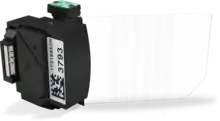 OE-32 |
| OE-40[12] | 640 (H) x 480 (V)FOV (Diagonal: 25°) | 2.0 mm Eye Motion Box @ 18 mm | 78% Image focal plane | 1000 fLContrast >250:1LOE | 18gr | 200mW |  OE-40 |
| OE-45 [13] | 640 (V) x 480 (H)FOV (Diagonal: 25°) | 1000 fLContrast >250:1LOE | 2.0 mm Eye Motion Box @ 18 mm | 78%Image focal plane: infinity | 15gr | <200mW | 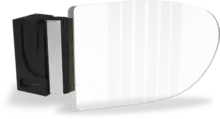 OE-45 |
| PD-14 | SVGA 800 x 600 pixels Field of View : 32° | Eye motion box: 10 x 10 mm | In active area >70%. Outside active area >92% | >1200 FL | <70gr | N/A |  PD-14 |
| PD-18 | SVGA 800 x 600 pixels Field of View : 32° | Eye motion box: 10 x 10 mm | In active area >70%. Outside active area >92% | >1200 FL | 70gr | N/A | 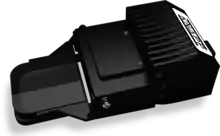 PD-18 |
Development Kits
| Dev Kit | Description | Image |
|---|---|---|
| DK-40[14] | The DK-40 is a fully comprehensive wireless, stand-alone monocular display development kit powered by the Lumus Optical Engine (OE) 40. The dev kit glasses have VGA resolution and 23° Field of View (FoV). The system contains an onboard OMAP processor running Android, embedded 9DoF motion sensor and a 5MP camera. The DK-40 enables true augmented reality capability by enabling direct image overlay over the wearer's main line-of-sight, coupled with the motion sensors and camera. Additionally, the unit comes with an SDK to program the onboard Application Processor (AP) and a client program that enables an Android phone to serve as a wireless remote control and mobile network back channel. | 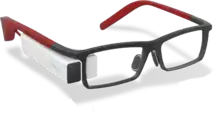 DK-40 |
| DK-45 [15] | The DK-45 is a fully comprehensive wireless, stand-alone monocular display development kit powered by the Lumus Optical Engine (OE) 45. The dev kit glasses have VGA resolution and 23° Field of View (FoV). The system contains an onboard OMAP processor running Android and embedded 9DoF motion sensor. The DK-45 enables true augmented reality capability by enabling direct image overlay over the wearer's main line-of-sight, coupled with the motion sensors. Additionally, the unit comes with an SDK to program the onboard Application Processor (AP) and a client program that enables an Android phone to serve as a wireless remote control and mobile network back channel. |  DK-45 |
| DK-50 [13] | The DK-50 is a fully comprehensive wireless, stand-alone binocular display dev kit powered by the Lumus Optical Engine, OE-32. OE-32 has 720p resolution, 40° Field of View (FoV). The system contains an onboard Snapdragon processor running Android, embedded 9DoF motion sensor, twin 4MP camera. The DK-50 enables immersive augmented reality capability by enabling direct image overlay over the wearer's main line-of-sight, coupled with the motion sensors and camera. Additionally, the unit comes with an SDK to program the onboard Application Processor (AP) and a client program that enables an Android phone to serve as a wireless remote control and mobile network back channel. |  DK-50 |
Partnerships
Lumus also has been working behind the scenes for years with a handful of Tier 1 consumer electronics manufacturers and tech companies, including Knapp AG, Thales, Daqri and Atheer.[16] The company aspires to be the Intel or the Qualcomm of the wearable display market—selling its optical engine modules as OEM components, while the Tier 1 companies will make the final products.[17]
History
- 2000: Lumus was founded by Dr. Yaakov Amitai to develop and market its Light-guide Optical Element (LOE) technology for eyewear displays (see-through wearable displays).
- 2008: The company started selling the PD-18: a top-down, transparent monocular display with SVGA resolution 32 degree field of view (FoV), and full color. The PD-18 and its derivative, the PD-14, were aimed at professional and military markets.[3]
- 2010: Lumus' technology received high level validation when the US Air Force selected Gentex's Scorpion Helmet Mounted Cueing System (which employs the Lumus PD-14), with Raytheon as the primary contractor, for the HMIT program for A-10 and F-16 Aircraft.[18] This display and contract win marked the first time a full color HMD was selected for combat aviation. Subsequently, Lumus' display as part of Thales Visionix's (formerly Gentex)Helmet Mounted Cueing System has been selected for the CHMDS / Air Soldier program. Once the roll out was completed on this program, Lumus displays represented the majority of HMDs deployed in the worldwide combat aviation market.[18]
References
- "AR Technology Innovator Lumus Appoints Ari Grobman as CEO". prweb. Retrieved 28 April 2017.
- "Company Overview of Lumus Ltd". Bloomberg.
- Glas, Kristijan (Jul 31, 2007). "Lumus – Future Video-Eyeglasses". The Future of Things.
- "Light guide optical device". Google Patents.
- tiny-augmented-reality-displays
- Feist, Jonathan. "Lumus – military grade technology in Android powered smart glasses". Android Authority.
- "Opgal and Lumus present thermal camera capabilities combined with eyewear at SPIE". Opgal.com. May 5, 2014.
- Davies, Chris (Mar 21, 2012). "Lumus OE-31 wearable display hands-on". Slash Gear.
- "Lenovo Unveils New Intelligent Devices and Solutions for Enterprise". May 13, 2019.
- Davies, Chris (Mar 21, 2012). "Lumus OE-31 wearable display hands-on". Slash Gear. Slash Gear.
- Boxall, Andy (March 10, 2014). "THESE SMARTGLASSES DISPLAY YOUR NOTIFICATIONS USING MILITARY-SPEC TECH". Digital Trends. Digital Trends.
- Davies, Chris (Dec 5, 2013). "Lumus DK-40 takes on Glass with true AR". Slash Gear. Slash Gear.
- Lee, Nicole (January 6, 2016). "Lumus wants its display optics in future smart glasses". Engadget.
- "Lumus DK40 smartglasses are your personal HUD (hands-on)". Cnet. January 7, 2014.
- Davies, Chris (January 7, 2016). "These Lumus displays could fix HoloLens' big problem". Slash Gear. Slash Gear.
- Atheer
- Meir, Noam. "Israel's Lumus and Opgal Team Up to Make Night Vision Enabled Google Glass Style Product". Jewish Business News.
- Spitzer, Cary (Sep 3, 2014). Digital Avionics Handbook (Third ed.). CRC Press. p. 16-13. ISBN 9781439868980.